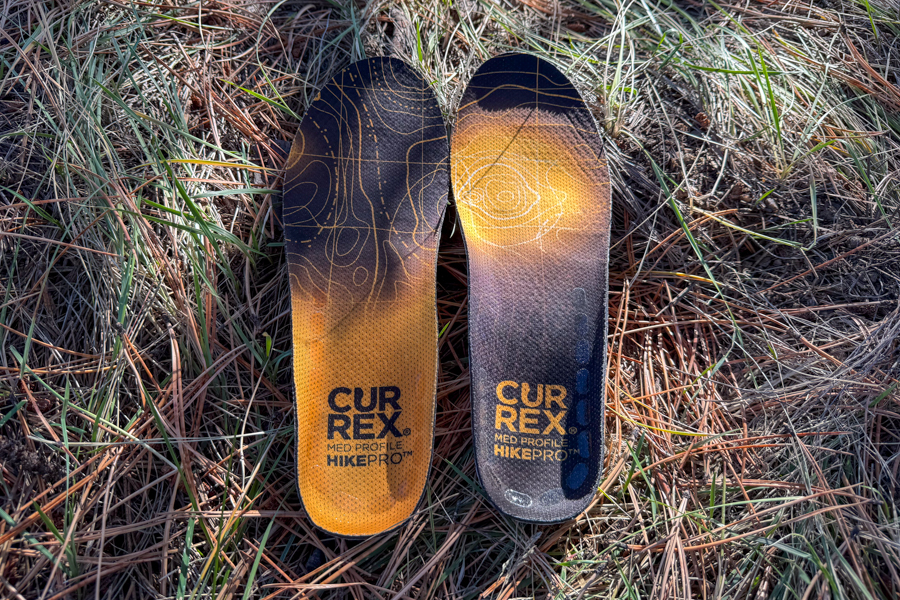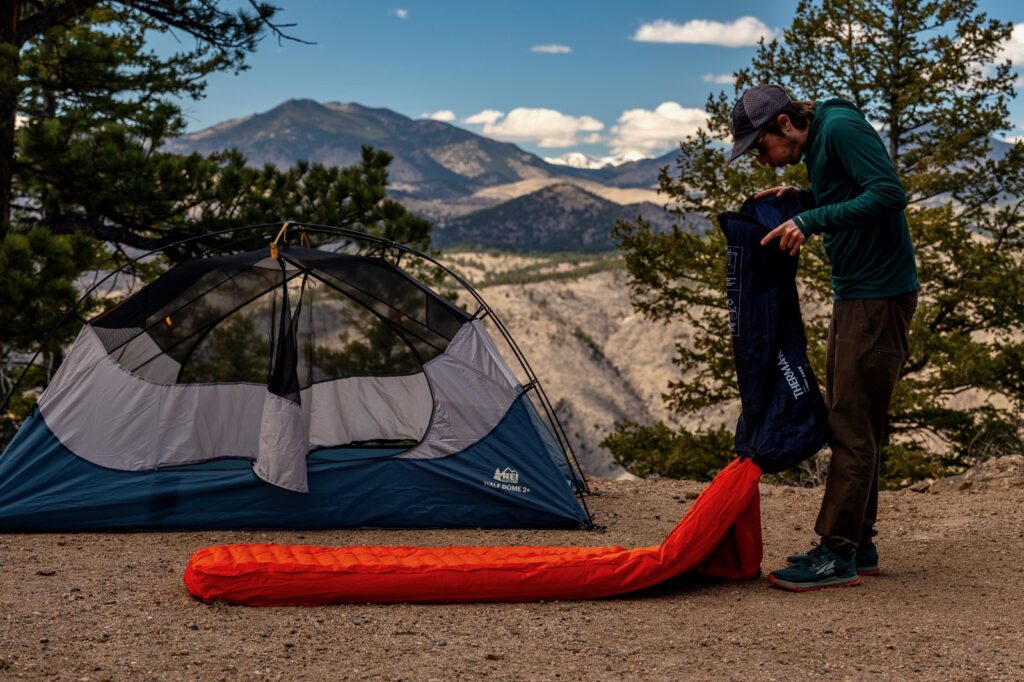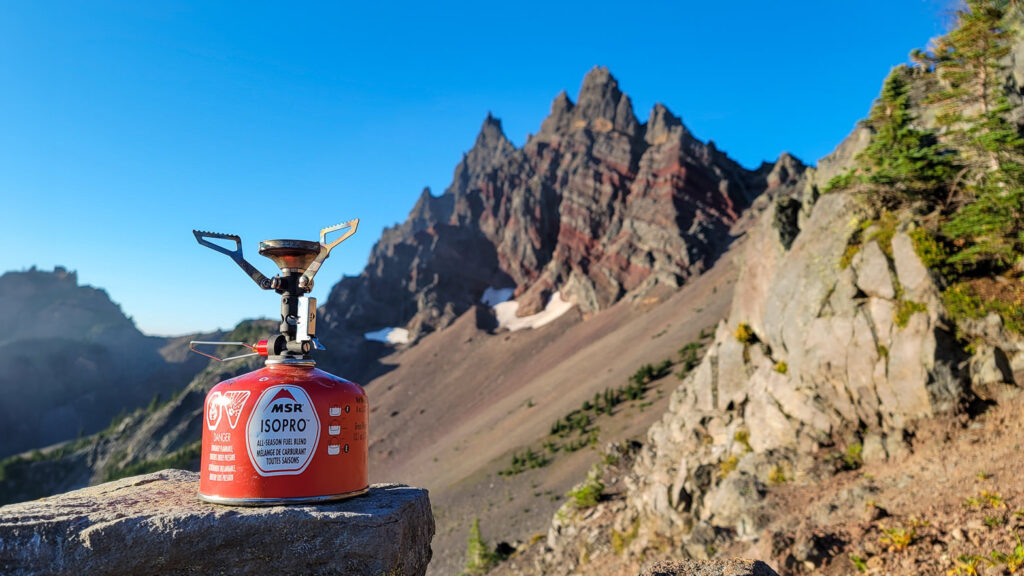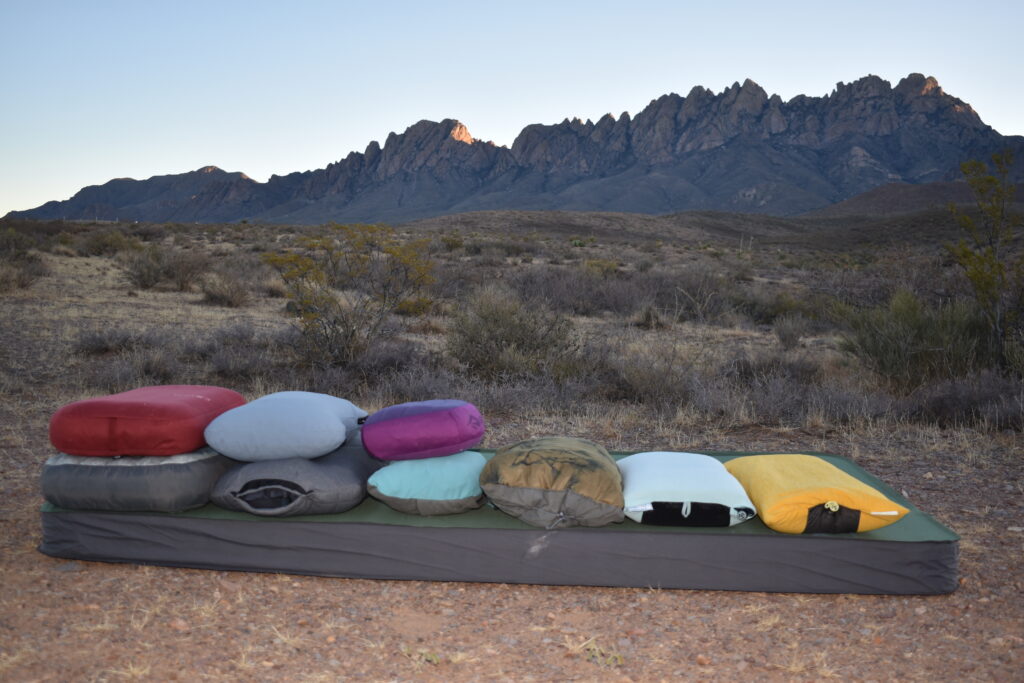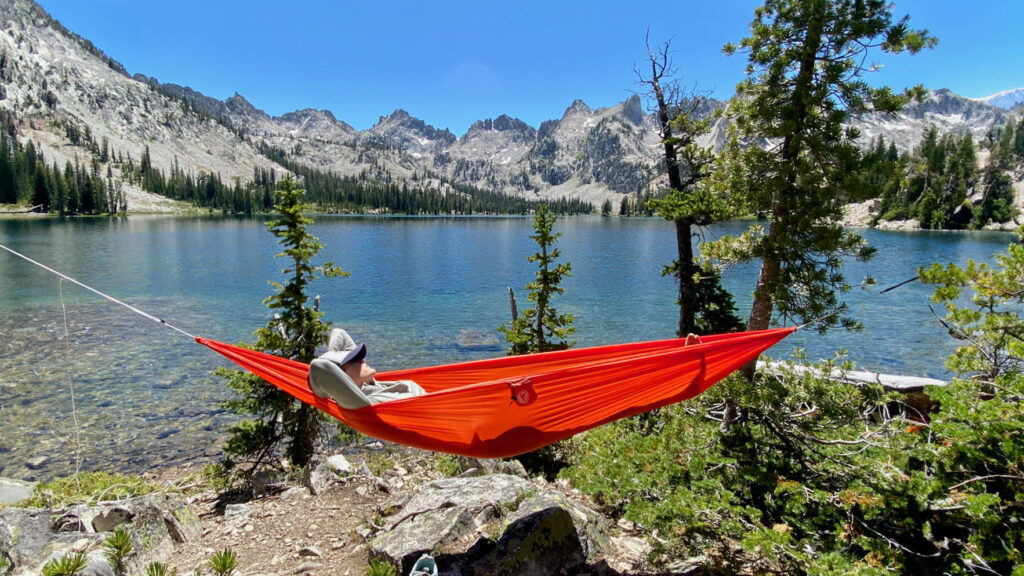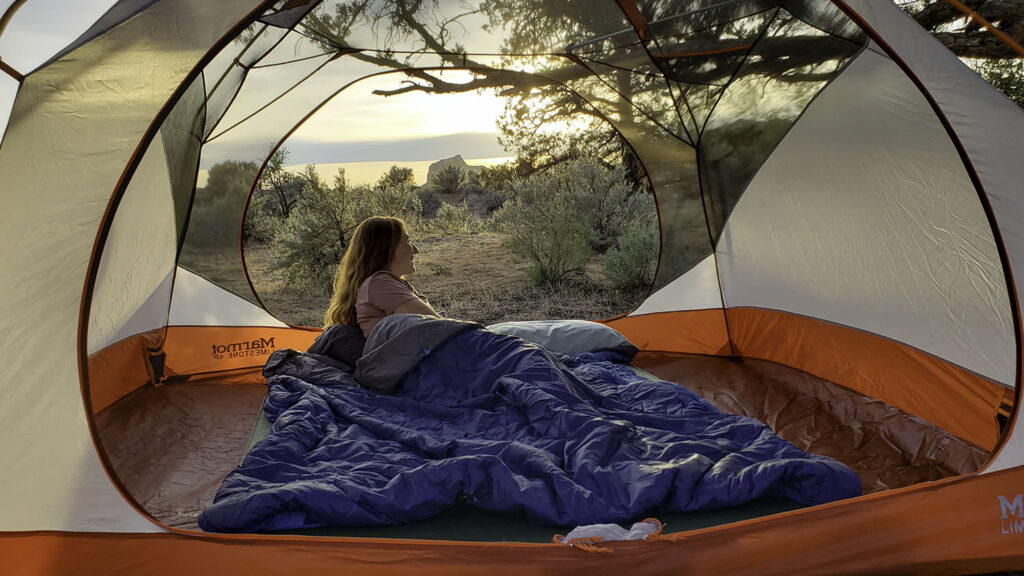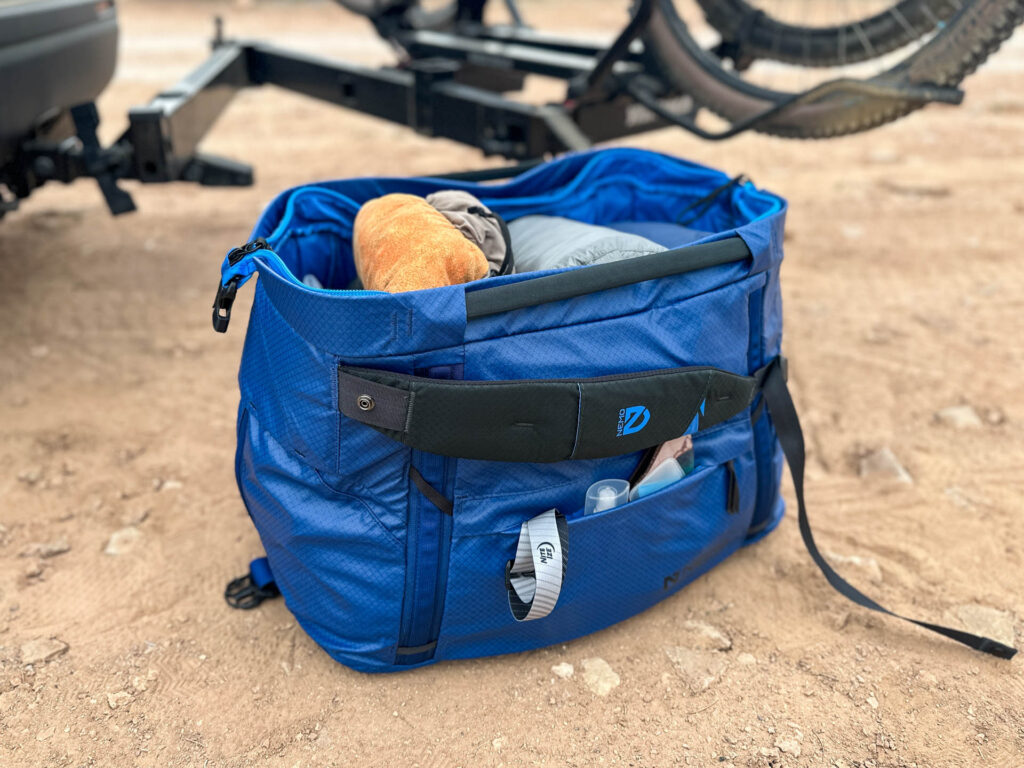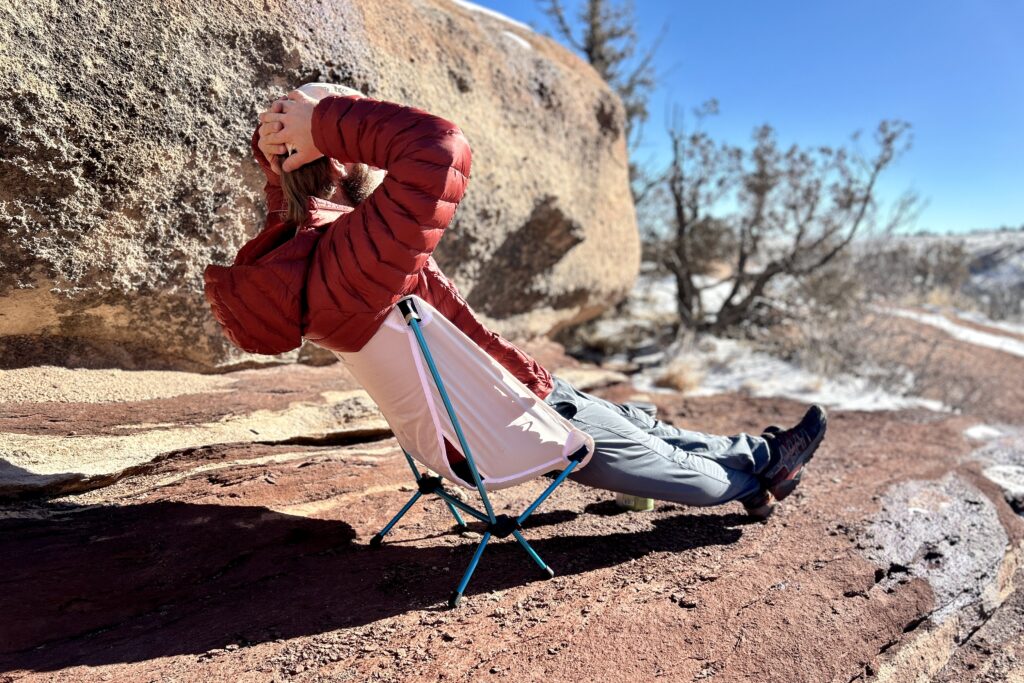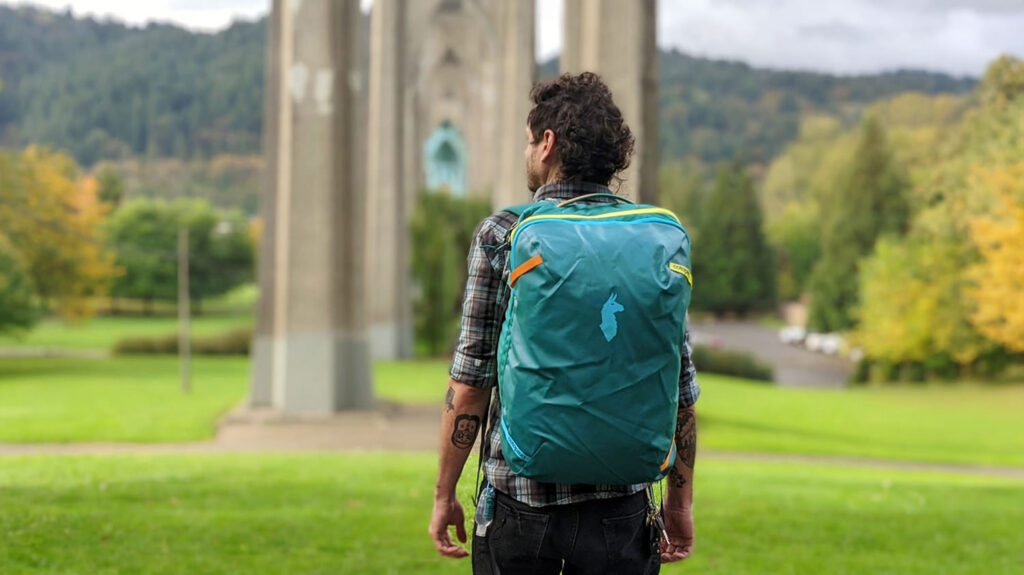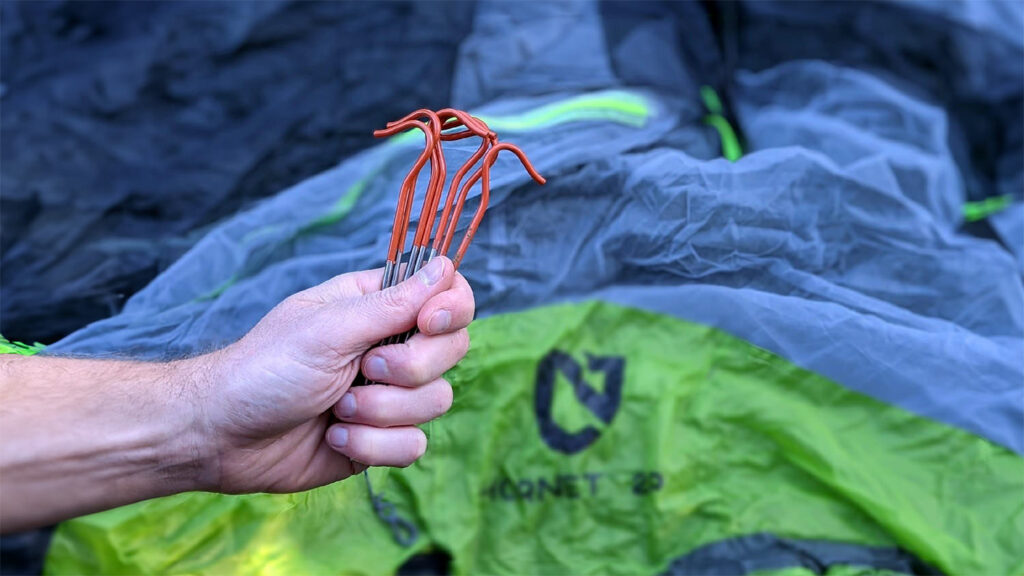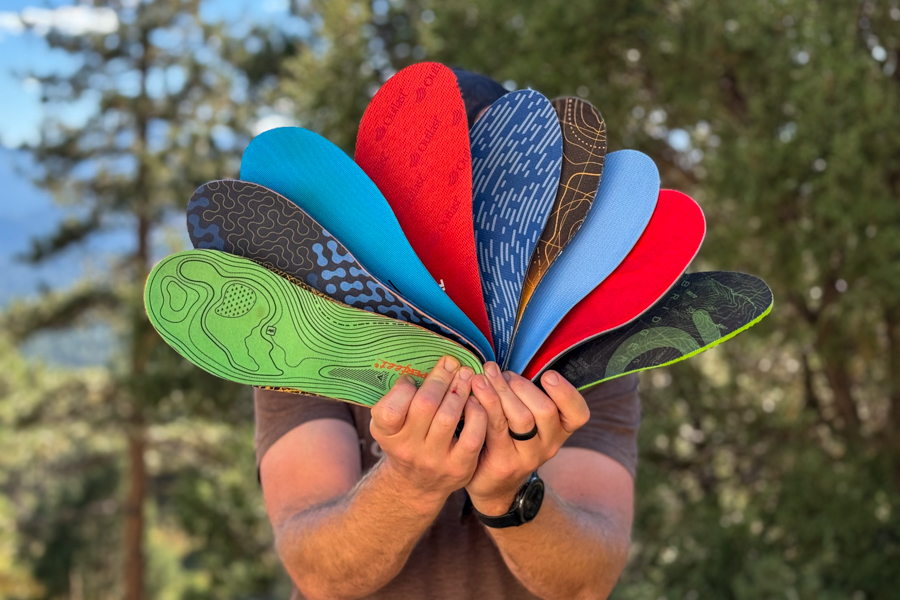
Hikers often overlook insoles, but they can be one of the most impactful upgrades to your setup. Whether you’re battling foot pain, nursing a nagging back issue, or just looking for more all-day comfort, the right insole can make a huge difference.
That said, picking the best insole isn’t always straightforward. It’s not like choosing a tent or a pack. Comfort and support are deeply personal. Some hikers need firm arch reinforcement. Others prioritize cushion or heel stabilization.
Our team tested a wide range of insoles across hundreds of miles, from rocky alpine scrambles to long-haul desert hikes. We scored each model on fit & comfort, support, durability, cushion, odor management, and value to help you find the perfect match for your foot shape and hiking or running goals. Whether you’re chasing relief or performance, we take the guesswork out of finding your ideal insole.
And for more info, check out some of our other popular gear guides:
Quick Picks for insoles
Best Insoles for Hiking: Currex HIKEPRO Medium Insoles ($65)
Best Insole that Molds to your Feet: SOLE Active Medium Insoles ($60)
Best Budget Insole for Hiking: Oboz Trail Insoles ($35)
Best Running Insole: Currex RunPro Medium Insoles ($60)
Best Insole with Multiple Arch Heights: Tread Labs Pace Insoles ($75)
Best Insole for Hiking Runner-up: Superfeet Hike Support Insoles ($60)
Best Running Insole with Extra Cushion: Superfeet Run Cushion Medium Arch Insoles ($60)
Best All-Purpose Insole with Extra Cushion: PowerStep Pinnacle Insoles ($44)
Best All-Purpose Insole: Superfeet All-Purpose Support Medium Arch (Blue) Insoles ($55)
Minimalist Insole for Heat Retention: Vivobarefoot Thermal Insole (Men’s / Women’s) ($14)
What’s new
This is a brand new gear guide, so everything is new! Here are our highlights:
- The Currex HikePro earns our Editor’s Pick for “Best Insole for Hiking,” thanks to its winning combo of lightweight comfort, reliable stability, and excellent heel control.
- Sole Active Medium Insoles are a close second for comfort and design. Their unique ability to mold to the foot earns them an Editor’s Pick badge.
- The Oboz Trail Insoles are our top budget pick. Despite their thin build, they offer surprising support and comfort, making them a great, affordable option for everyday hikes.
Overall Testing Scores for insoles
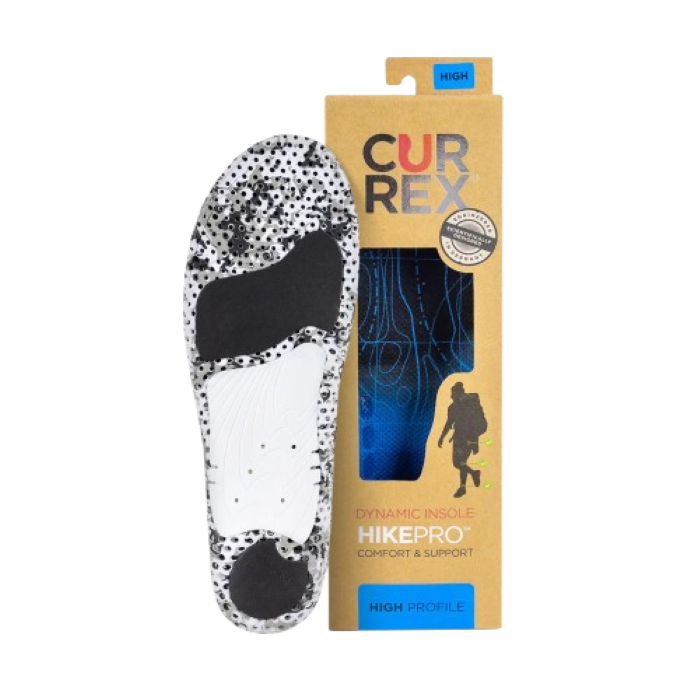
CURREX HIKEPRO Medium Insoles
Best Insoles for Hiking
CleverHiker Rating: 4.9/5.0
Price: $65
Measured Weight: 1.7 oz.
Arch Height: Medium (also available in Low, High)
Pros
- Lightweight
- Comfortable
- Reduces foot fatigue
- Great stability & heel control
- Breathable
Cons
- Could be more cushioned
- Rigid arch support
- Not a good fit for low-volume footwear
The Currex HIKEPRO Medium Insoles stood out in our testing as the only insoles we forgot we were even wearing. That’s exactly what we want from a great insole. Their subtle support felt natural, never intrusive. Yet, by the end of long days on trail, our analysts noticed significantly less foot fatigue and fewer aches. For our lead gear analyst on this project, who suffers from plantar fasciitis, the HIKEPROs were one of the few insoles that actually helped reduce discomfort over the course of several 10+ mile hikes with a 35+ lb pack.
These insoles offer just the right balance of structure and flexibility for medium arches. The deep heel cup provides mild stabilization, and the cushioned forefoot helps reduce pressure without feeling mushy or bulky. They’re also highly breathable and moisture-wicking, which we appreciated on warm and long-haul hikes.
Although the HIKEPROs might not be the best choice for hikers with severe foot conditions, extremely flat feet, or high arches, they’re an excellent all-purpose choice for most people. They’re available in high, medium, and low arch profiles, so you can get a more tailored fit no matter your foot shape.
If you want an insole that quietly improves your comfort and lets you forget about your feet – even on challenging trails – this is the one to get. That mix of ease, relief, and low-profile performance earns the Currex HIKEPRO our top recommendation for hiking insoles.
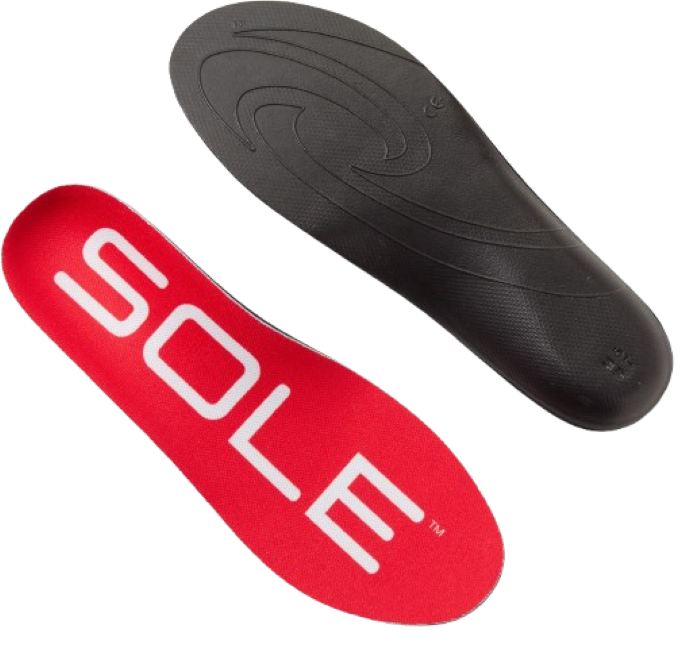
SOLE Active Medium Insoles
Best Insole that Molds to your Foot
CleverHiker Rating: 4.8/5.0
Price: $65
Measured Weight: 2.4 oz.
Arch Height: Medium (also available in thin, thick)
Pros
- Good arch support
- Heat or wear moldable custom fit
- Durable
- Zero drop / low profile
- Good odor control
Cons
- Arch placement can feel off
- Could be more cushioned
- Somewhat high volume
- Longer break-in period
If we had to rank the SOLE Active Medium Insoles after just a hike or two, they honestly wouldn’t have made our top tier. Our analysts still found them reasonably comfortable out of the box, but they felt a bit rigid and unnatural, especially compared to more cushioned or flexible options. That said, that initial stiffness is intentional: these insoles are designed to mold to your feet over time, either gradually through use or more quickly with heat (like a hair dryer or heat gun).
By our third hike – around the 15-mile mark – we started to feel the benefits. The footbed softened up in just the right places, providing noticeable relief for testers prone to arch and heel fatigue. One analyst who manages recurring plantar fasciitis said the SOLEs delivered some of the most effective long-term support of any insole he’s tested – once it’s fully molded.
The Active Medium uses EVA foam with a moderate arch profile and deep heel cup. This delivers a stable, locked-in feel without being overly aggressive or intrusive. They’re especially well-suited for hikers who want structured support on long treks or heavier pack days. These aren’t the plushest insoles we tested, and they take some patience. But, if you’re looking for a durable, custom-feeling fit, the SOLE Active Mediums are a good long-term option once broken in.
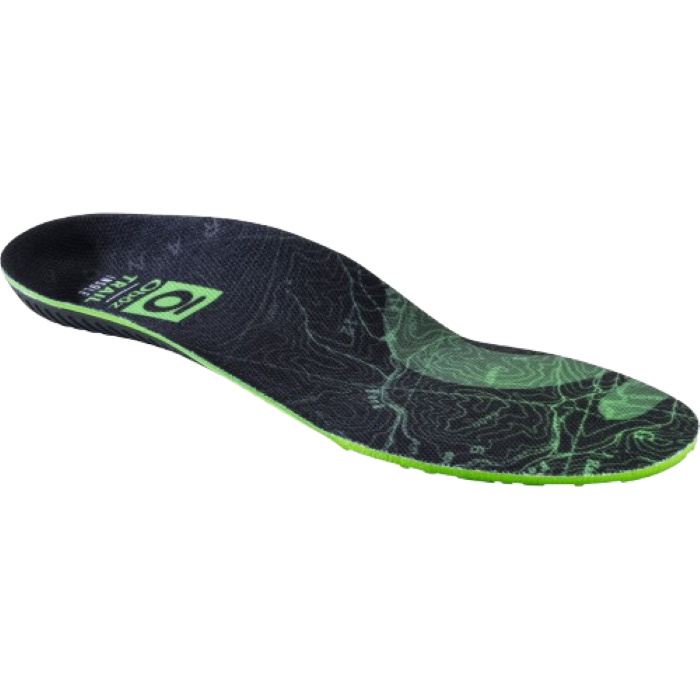
Oboz Trail Insoles
Best Budget Insole for Hiking
CleverHiker Rating: 4.7/5.0
Price: $35
Measured Weight: 2.2 oz.
Arch Height: Medium/High
Pros
- Affordable
- Low Volume
- Targeted shock absorption
- Little to no break-in period
- Good arch support for flat feet
Cons
- Runs a little large
- Not as firm as other options
- Less durable than some
The Oboz Trail Insoles are a budget-friendly, mid-level upgrade for hikers seeking more support and comfort without going full orthotic. On our first hike, they felt slightly firmer than stock insoles, giving a bit of structure – but not so much that we felt them all day. Over several dozen trail miles, they helped reduce foot fatigue, especially on rocky trails, and offered a mild but welcome boost in support. The targeted shock absorption zones in the heel and forefoot did a great job of softening impact, and the overall rebound and cushioning feel surprisingly responsive for such a flexible insole.
What we like most about these insoles is how they balance firmness and flexibility. The arch and heel support help guide foot alignment, and the forefoot area remains responsive for a more natural feel. They also seemed to manage moisture decently. We experienced no slippages or discomfort, even when things got damp.
For hikers with very high arches or serious foot issues, the support may not be strong enough; these insoles are more of a middle ground, not a cure-all. Durability is solid for what they are, but don’t expect lifetime performance.
If you hike regularly and want a little extra support and structure without going extreme, the Oboz Trail Insoles are a dependable, user‑friendly choice. They won’t transform your boots, but they’ll quietly make many miles more comfortable.
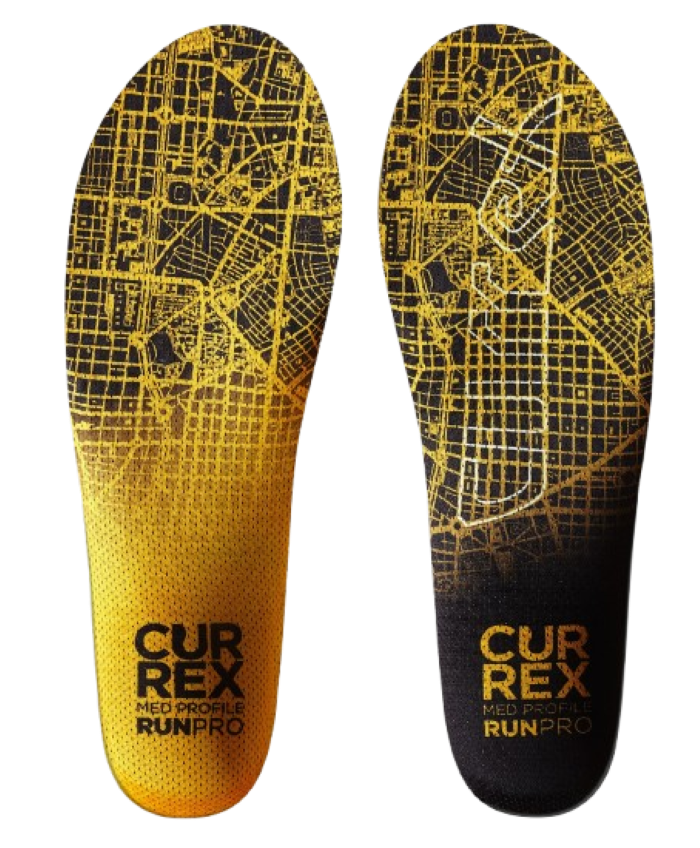
CURREX RUNPRO Insoles
Best Running Insole
CleverHiker Rating: 4.7/5.0
Price: $60
Measured Weight: 1.8 oz.
Arch Height: Medium (also available in low, high)
Pros
- Good support without being overbuilt
- Low Volume
- Lightweight
- Cushioned yet supportive
- Zero heel-to-toe drop
Cons
- Short lifespan for the price
- Expensive
There’s a lot to appreciate about the Currex RunPro Medium Insoles. Designed specifically for low-profile running shoes, these insoles are an easy upgrade that doesn’t mess with the original feel of your expensive running shoes. Our team especially liked the zero-drop design, which maintains the natural ride of trail runners and road shoes alike. Even our analysts who typically avoid insoles found these to be a comfortable addition, offering subtle support without feeling bulky or intrusive.
We noticed reduced foot fatigue and fewer hot spots during long runs on both pavement and trails. The low-profile shape makes them easy to slip into most shoes without compromising fit or toe box space. The cushioning walks the line between responsive and supportive without feeling overly plush or mushy. That said, they may not be ideal for people with high arches or more serious stability needs. Luckily, this insole is available for low, medium, and high arch versions.
One area worth watching is long-term durability. We’ve had no problems after 100+ miles of testing, but several user reviews mention premature wear, especially the top layer separating from the foam beneath. It hasn’t happened to us yet, but it’s something we’ll monitor over time.
Ultimately, the Currex RunPro Medium Insoles are an excellent pick for runners and fast-moving hikers looking for a lightweight insole that improves comfort without calling attention to itself. Slip them in and go. Your feet will thank you later.
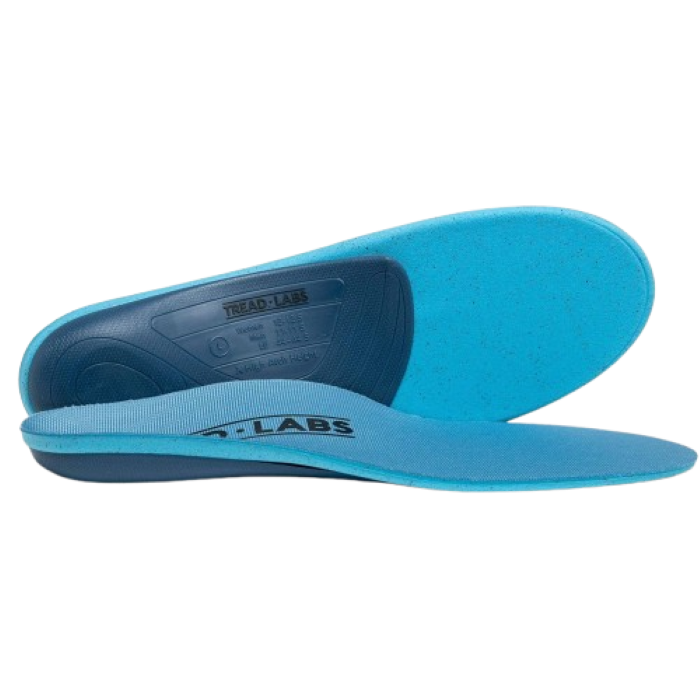
Tread Labs Pace Insoles
Best Insole with Multiple Arch Heights
CleverHiker Rating: 4.6/5.0
Price: $75
Measured Weight: 2.5 oz.
Arch Height: Low, Medium, High, Extra High
Pros
- Excellent warranty
- Replaceable top cover
- Very secure
- Antimicrobial treatment for odor control
Cons
- Expensive
- Runs hot
- Break-in period
- A bit bulky
The Tread Labs Pace Insoles are an excellent choice for anyone seeking structured, long-lasting support without compromising comfort. Their modular design – with multiple arch heights and a replaceable top cover – means they adapt to a wide range of feet and last longer than most standard insoles. The firm support and deep heel cup help lock your foot in place, improving alignment and reducing fatigue, even over long hikes.
When we first put them in our shoes, they felt noticeably stiff, especially for analysts accustomed to softer or flatter stock insoles. There’s a moderate break-in period, but after a few hikes, they began to feel far more natural.
The added bulk may require trimming, and they’re not the best fit for tight or low-volume footwear. For roomier hiking boots or trail runners, however, they settle in nicely.
What impressed us most was how well they disappear once broken in. After 30+ miles in the Rockies and multiple, full-day tests, our analysts consistently reported reduced soreness and better posture with these insoles. Unlike many cheaper options that lose structure quickly, the Pace remains firm and supportive well beyond the typical lifespan.
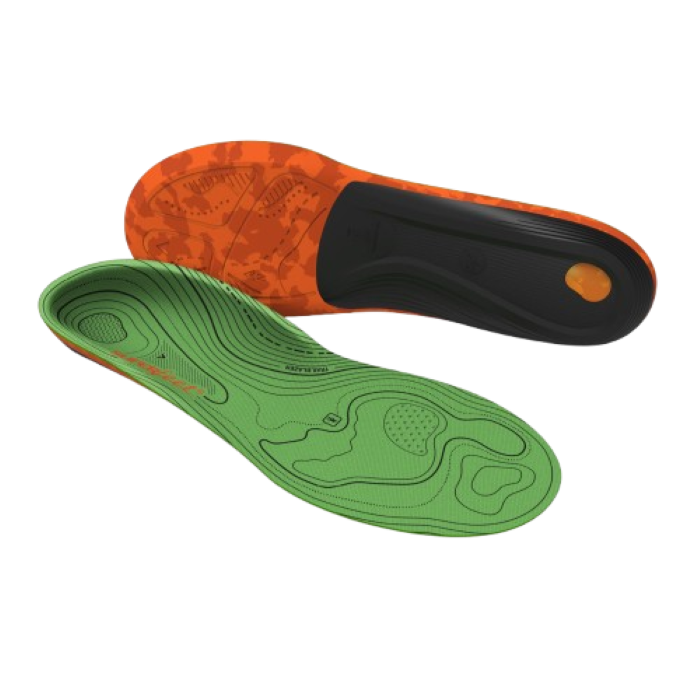
Superfeet Hike Support Insoles
Best Insole for Hiking Runner-up
CleverHiker Rating: 4.6/5.0
Price: $60
Measured Weight: 2.5 oz.
Arch Height: Medium, High
Pros
- Well constructed
- Excellent impact absorption & cushioning
- Firm arch support
- Deep heel cup
Cons
- Expensive
- Break-in period
- Not the best for wide feet
The Superfeet Hike Support Insoles are a tried-and-true favorite among hikers for good reason. Their reputation for durable, high-quality construction is well-deserved, and our analysts found them to be both comfortable and supportive. The firm arch and deep heel cup offer a locked-in feel that helps stabilize the foot and reduce fatigue, which is especially helpful on longer hikes or when carrying a heavier pack.
We appreciate the generous cushioning, which provides noticeable impact protection on rocky trails and steep descents. Compared to some of the more minimalist insoles we tested, the Hike Support feels plush without being spongy, providing a responsive and reliable feel even on days exceeding 10 miles. With that being said, the structured shape may feel aggressive to some users at first, especially those who are new to aftermarket insoles or who have flat arches. We found that most hikers adjust quickly.
They aren’t the lightest or lowest-profile option, but the Superfeet Hike Support insoles are among the most supportive. This makes them a great choice for backpackers, thru-hikers, and anyone who needs extra support for extended days on trail. If your feet tend to get sore by the end of a hike or you’ve struggled with arch pain, these insoles could be a game-changer. They’re not flashy, but they’ve earned their place as a dependable staple for thousands of hikers. We think they’re still one of the best.
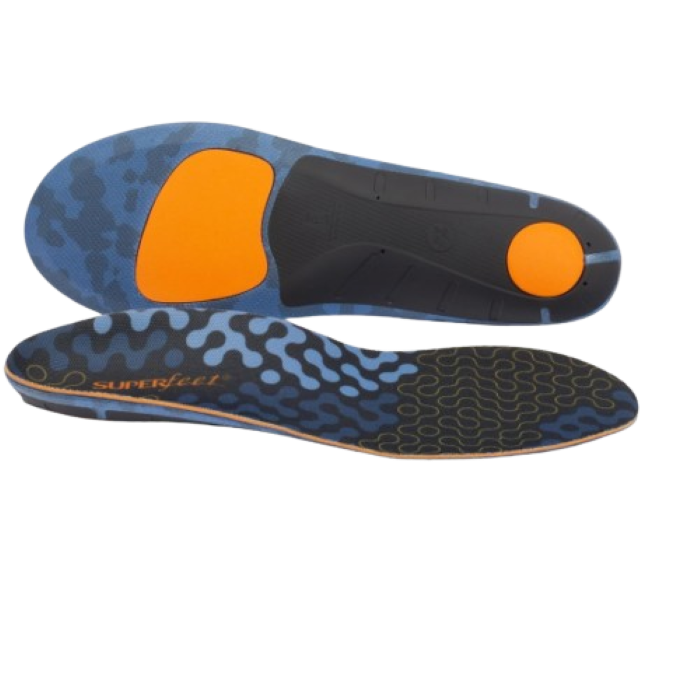
Superfeet Run Cushion Medium Arch Insoles
Best Running Insole with Extra Cushion
CleverHiker Rating: 4.5/5.0
Price: $60
Measured Weight: 2.0 oz.
Arch Height: Medium (also available in low, high)
Pros
- Comfortable
- Plenty of cushion
- Good rebound
- Low-volume fit for running shoes
Cons
- Expensive
- Users report durability issues
The Superfeet Run Cushion Medium Arch Insoles are another popular option from Superfeet, and they share a lot in common with the brand’s Hike Support Insoles. However, we noticed a few key differences that make these better suited for running. Although, we hiked in them too, and honestly, it was great.
The Run Cushion line comes in three different arch heights, making it accessible for users with a variety of foot shapes. Compared to the Hike Support, these insoles (as the “cushion” in the name suggests) offer softer, more forgiving cushioning and feel noticeably more flexible.
Like other running-focused models we’ve tested, these feature energized cushioning zones in the heel and forefoot. These zones enhance rebound and help absorb impact during high-stride activities like running or fast-paced hiking.
Thanks to their low-volume design, they fit well in slim-profile trail runners and provided just enough subtle arch support to reduce foot fatigue, which we found to be especially noticeable on long downhill stretches.
They didn’t drastically alter the ride of our trail runners or running shoes, but they noticeably improved comfort by reducing vibration and impact on hard surfaces. The cushioning feels responsive, not overly plush, which our analysts appreciate for preserving ground feel and agility.
We wouldn’t recommend them for runners who require strong corrective support or those who experience significant overpronation. For that, firmer, more structured options will be a better fit. But for everyday training where your feet just need a little extra love, these insoles are a lightweight and worthwhile upgrade.
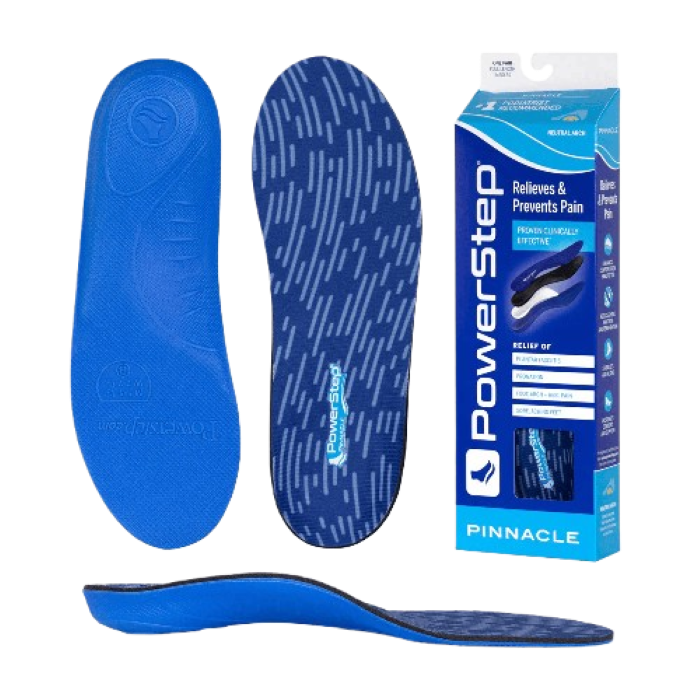
Powerstep Pinnacle Insoles
Best All-Purpose Insole with Extra Cushion
CleverHiker Rating: 4.3/5.0
Price: $44
Measured Weight: 2.4 oz.
Arch Height: One Size
Pros
- Helps with pain relief
- Comfort
- Highly cushioned
- Antimicrobial top sheet
- Helps with plantar fasciitis
Cons
- High volume
- Possible durability issues
Here’s the thing: every insole we tested, except for the Vivobarefoot, claims to help with plantar fasciitis. That’s great marketing, but in real-world testing, only one truly delivered relief for our lead insole analyst (who actually suffers from plantar fasciitis). That was the PowerStep Pinnacle. Along with the SOLE Active Insoles, it was the rare insole that meaningfully reduced discomfort after long days on trail or concrete.
These insoles are thicker, heavier, and more structured than most hiking or running-specific insoles we tested. They’re not our top pick for squeezing into low-profile trail runners or ultralight shoes, but they did well in roomier boots and everyday footwear. They felt a bit bulky at first, especially in tighter-fitting shoes. After a few hikes, however, the foam broke in, and the fit became more forgiving.
The Pinnacle has a deep heel cup, firm arch support, and an all-around structured feel. Though some people prefer a softer or more flexible insole, the tradeoff is well worth it if foot pain is your main concern. If you’re someone who has tried everything for heel or arch pain and still haven’t found relief, the PowerStep Pinnacle might be the solution you didn’t know you needed. Just be sure your footwear has enough room to accommodate it.
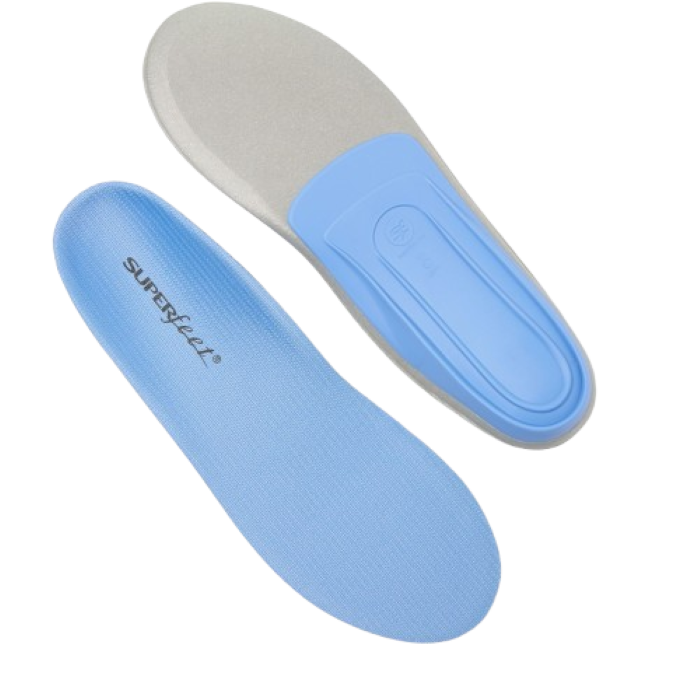
Superfeet All-Purpose Support Medium Arch Insoles
Best All-Purpose Insole
CleverHiker Rating: 4.1/5.0
Price: $55
Measured Weight: 2.0 oz.
Arch Height: Medium (also available in low, high)
Pros
- Heel stability
- Close to stock insole thickness
- Good starter insoles
- Comfy
- Supportive
Cons
- Longer break-in period
- Durability with top sheet
- Can be difficult to size
The Superfeet All-Purpose Support Medium Arch Insoles, often referred to simply as Superfeet Blues, are a longstanding favorite among those dipping their toes (literally) into the world of aftermarket insoles. These are commonly recommended as a first upgrade because they’re almost as thin as stock insoles, which makes them easy to transition into without altering the fit of your shoes. During our testing, we appreciated how seamlessly they slid into both trail runners and casual sneakers without crowding the toe box or drastically changing the ride. The arch support is firm yet unobtrusive, making it a good fit for people with medium-height arches who don’t need aggressive correction.
However, these aren’t the most cushioned or plush insoles in our lineup. They offer minimal shock absorption and can feel quite firm, particularly for those used to spongier stock liners or aftermarket insoles. Our analysts noted a definite break-in period, but things started to loosen up after a few days of use. While these insoles have held up well for our crew so far, a common concern in user reviews is the potential for the top sheet to delaminate from the rest of the insole. We haven’t experienced this issue ourselves, but we’ll continue monitoring durability through long-term testing – and will update our gear guide if anything changes.
The Superfeet Blues offer plenty of comfort and support, making them a solid choice for anyone who wants a little extra structure without overdoing it. If you’re new to insoles and just want something straightforward, reliable, and easy to wear day after day, this longtime favorite is a great place to begin.
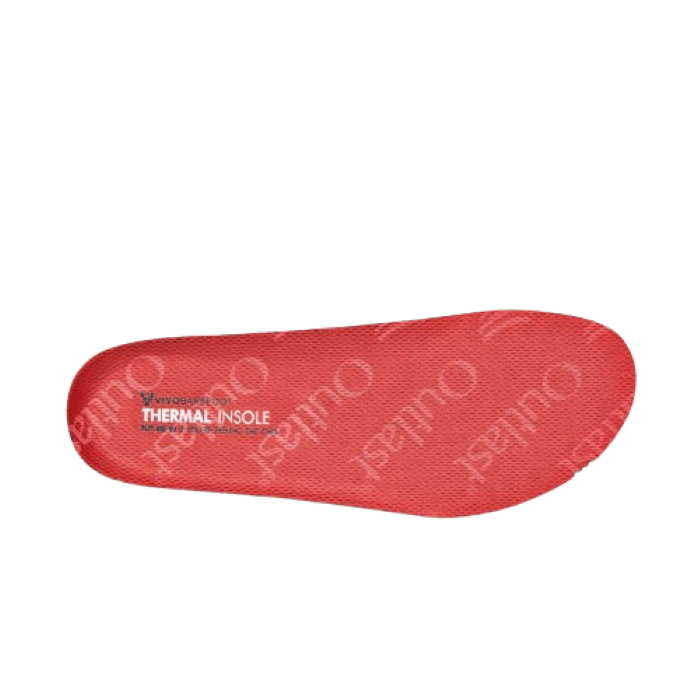
Vivobarefoot Thermal Insoles
Best Minimalist Insole for Heat Retention
CleverHiker Rating: 3.8/5.0
Price: $14
Measured Weight: 1.2 oz.
Arch Height: One Size
Pros
- Inexpensive
- Lightweight
- Warm
- Low Profile
- Preserves barefoot feel in minimalist shoes
Cons
- Minimal support
- Minimal cushion
First and foremost, the Vivobarefoot Thermal Insoles occupy a different niche than most of the insoles we tested for this gear guide. They’re designed primarily to add a layer of thermal insulation to your existing footwear without compromising ground feel or the natural movement of your foot. While Vivobarefoot makes minimalist footwear, we tested these insoles not only in our Vivobarefoot Trackers but also in more traditional hiking boots like the Oboz Katabatic LT and Salomon Quest 4.
These insoles don’t provide meaningful arch or heel support, but they do add a touch of cushioning. Depending on the shoes you use them with, they may even feel thinner than your stock insoles.
When it comes to heat retention, they perform pretty well. There are certainly warmer and more supportive thermal insoles out there, but that’s not really the point here. The Vivobarefoot Thermal Insoles are for hikers who want a subtle boost in warmth without introducing artificial structure or losing that barefoot feel. For that specific purpose, they deliver exactly as intended.
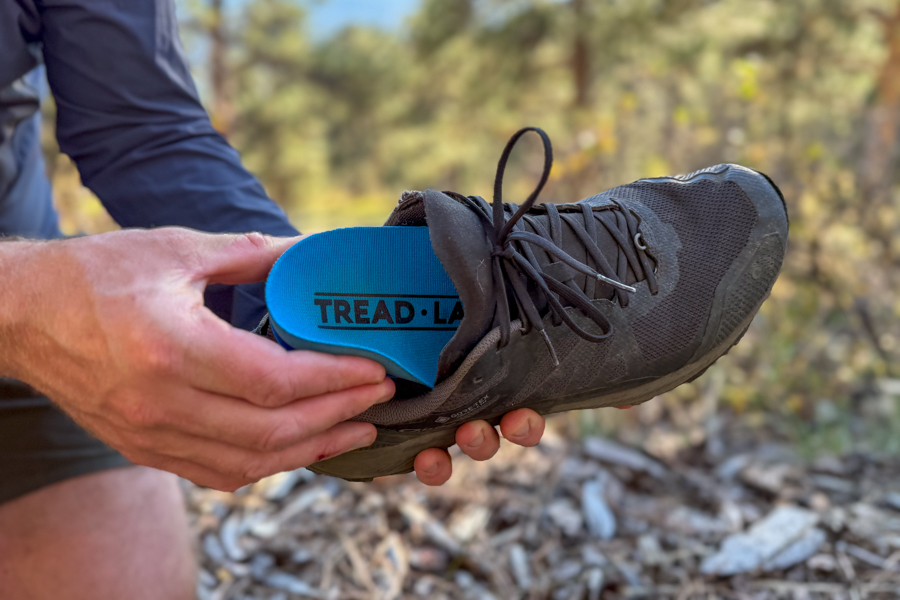
Product Comparison Table
| oSort | Product | CleverHiker Rating | Price | Measured Weight | Arch Height | Comfort & Fit | Support | Durability | Cushioning | Odor Control | 0 |
CURREX HIKEPRO Medium Insoles View at REI View at Amazon |
4.9/5.0 | $65 | 1.7 oz. | Medium (also available in Low, High) | 4.9 | 4.6 | 4.8 | 4.6 | 4.9 | 1 |
SOLE Active Medium Insoles View at REI View at SOLE |
4.8/5.0 | $65 | 2.4 oz. | Medium (also available in thin, thick) | 4.8 | 4.8 | 4.8 | 4.7 | 4.8 | 2 |
Oboz Trail Insoles View at REI View at Oboz |
4.7/5.0 | $35 | 2.2 oz. | Medium/High | 4.7 | 4.7 | 4.3 | 4.5 | 4.5 | 3 |
CURREX RUNPRO Insoles View at REI View at CURREX |
4.7/5.0 | $60 | 1.8 oz. | Medium (also available in low, high) | 4.9 | 4.6 | 4.7 | 4.6 | 4.9 | 4 |
Tread Labs Pace Insoles View at Amazon View at Tread Labs |
4.6/5.0 | $75 | 2.5 oz. | Low, Medium, High, Extra High | 4.8 | 4.8 | 4.5 | 4.6 | 4.5 | 5 |
Superfeet Hike Support Insoles View at REI View at Superfeet |
4.6/5.0 | $60 | 2.5 oz. | Medium, High | 4.5 | 4.8 | 4.8 | 4.6 | 4.7 | 6 |
Superfeet Run Cushion Medium Arch Insoles View at REI View at Amazon |
4.5/5.0 | $60 | 2.0 oz. | Medium (also available in low, high) | 4.5 | 4.8 | 4.8 | 4.8 | 4.7 | 7 |
Powerstep Pinnacle Insoles View at Amazon View at Powerstep |
4.3/5.0 | $44 | 2.4 oz. | One Size | 4.3 | 4.8 | 4.5 | 4.7 | 4.4 | 8 |
Superfeet All-Purpose Support Medium Arch Insoles View at Amazon View at REI |
4.1/5.0 | $55 | 2.0 oz. | Medium (also available in low, high) | 4.1 | 4.4 | 4.8 | 4.4 | 4.7 | 9 |
Vivobarefoot Thermal Insoles View Men's View Women's |
3.8/5.0 | $14 | 1.2 oz. | One Size | 3.8 | 3.7 | 4.3 | 3.7 | 4.7 |
|---|
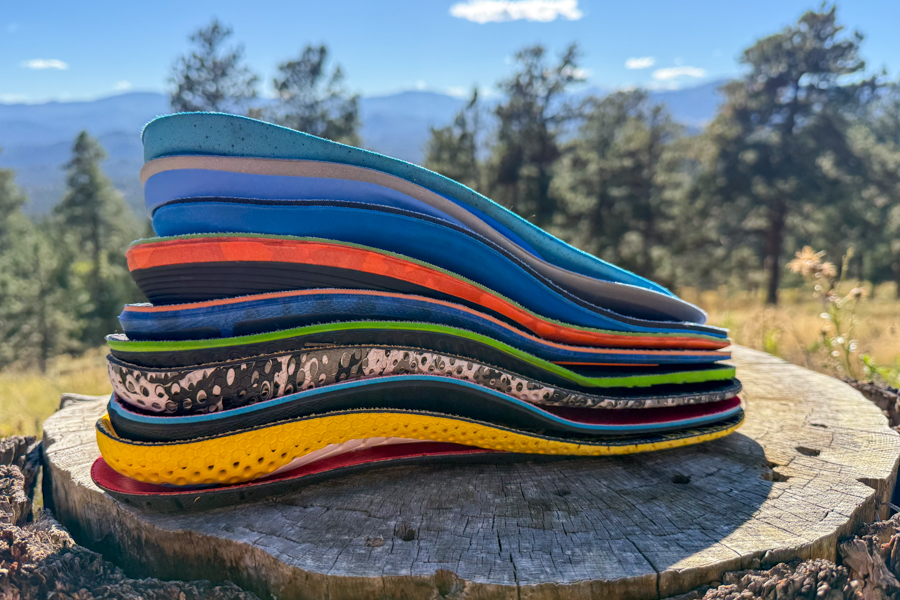
How We Test & Methodology
Because insoles are such a personal piece of gear, we took our time to evaluate each one over the course of three months. Most insoles require a break-in period, and some are heat-moldable or designed to conform gradually to your foot shape over time. To get a full and accurate picture, we logged at least 50 trail miles with each insole, rotating them through a wide range of hiking boots, trail runners, and everyday shoes.
Testing took place across Colorado’s foothills and high country – from dry, rocky terrain in the Front Range to wet, root-filled alpine trails at elevation. Our goal was to understand not just how these insoles felt straight out of the box but how they performed after many miles of real use.
FIT & COMFORT
To assess fit and comfort, we focused on how each insole interacted with different types of footwear and foot shapes over time. We rotated insoles through a range of trail runners, hiking boots, and daily-wear shoes to see how they conformed, compressed, and retained their shape over time.
Since many insoles have a break-in period, or mold to your foot with body heat, we didn’t just rely on initial impressions. Instead, we wore each pair for long runs & hikes (often over 10 miles) and noted how they felt at mile 2 versus mile 20. We paid close attention to pressure points, arch contact, and whether the insole added bulk or took up too much volume in low-profile footwear.
Our analysts logged notes on hot spots, toe room, and general underfoot feel, especially on long descents, on uneven terrain, or under a heavy load. Insoles that disappeared underfoot – meaning we didn’t think about them while hiking – tended to rank the highest. Conversely, those who created any discomfort or distraction were knocked down in our scoring. Ultimately, comfort isn’t one-size-fits-all, so we made sure to include feedback from analysts with different arch types, foot widths, and sensitivities.
SUPPORT
Support is one of the most important metrics we evaluate because it directly affects how your feet, ankles, and knees feel after a long day on trail. To assess it, we looked at how each insole stabilized the foot and distributed pressure during motion, especially under heavy loads or uneven terrain. We paid close attention to arch height and rigidity, heel cup depth, and midfoot structure, noting whether each design encouraged proper alignment or caused overcorrection.
During testing, our analysts hiked and ran with varying pack weights to see how well the insoles resisted collapsing over time. We also noted how they performed on long descents, when tired feet tend to roll inward, and whether they helped reduce pronation or heel slippage.
Ultimately, the best insoles provided structured, consistent support that reduced fatigue and improved stability mile after mile without creating unwanted pressure points or stiffness.
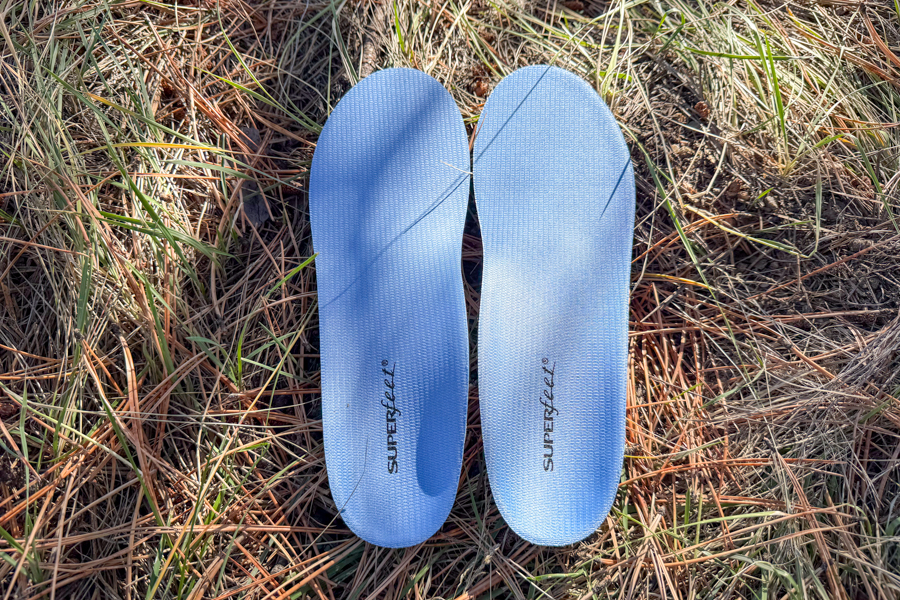
DURABILITY
Durability testing for insoles focuses on how well they maintain structure, cushioning, and integrity over time. Our team logged at least 50 trail miles per pair – often much more. After each test block, we inspected for delamination, compression, cracking, and surface wear, especially at flex points and the heel cup, where breakdown is most common.
We paid close attention to how each insole’s materials, whether EVA foam, polyurethane, or proprietary blends, held up after repeated stress. Some lightweight models compressed quickly, losing support. Some premium or dual-density foams proved far more resilient. We also tracked odor and moisture retention, both of which can signal material degradation. More on that below.
Cushion
To evaluate cushioning, we tracked how each insole absorbed impact and distributed pressure during long hikes, runs, and daily wear. Our analysts focused on the feel of the heel strike and forefoot rebound, noting whether the insole offered plush cushioning, responsive cushioning, or a firmer, more structured ride. Testing included both high-impact trail descents and long days on hardpack or pavement to simulate real-world fatigue.
We also tracked how the foam density held up over time. Some insoles compressed noticeably after 20–30 miles; others retained their bounce and comfort after 50+ miles. Those with targeted impact zones in the heel and forefoot tended to perform best for shock absorption, especially under heavier loads. Ultimately, the best insoles provided a balance between softness and stability, offering comfort that reduced fatigue without feeling spongy or disconnecting you from the trail.
ODOR MANAGEMENT
To gauge odor management, we took note of how well each insole handled moisture and prevented odor buildup over time. Our testing involved multi-day hikes, hot-weather runs, and high-mileage days in various footwear, including trail runners, hiking boots, and some very old and smelly daily trainers. After each use, we paid close attention to smell retention, especially after back-to-back days without allowing insoles to fully dry out.
Insoles with antimicrobial treatments or moisture-wicking topsheets performed noticeably better in resisting odor, especially under sweaty, high-output conditions. We also noted whether the materials dried quickly overnight and whether smell returned after washing or airing out.
Some models stayed surprisingly neutral after 50+ miles. Others began to develop a funk within just a few days. Though no insole is completely immune to odor over time, the best options resist buildup and stay fresh longer.
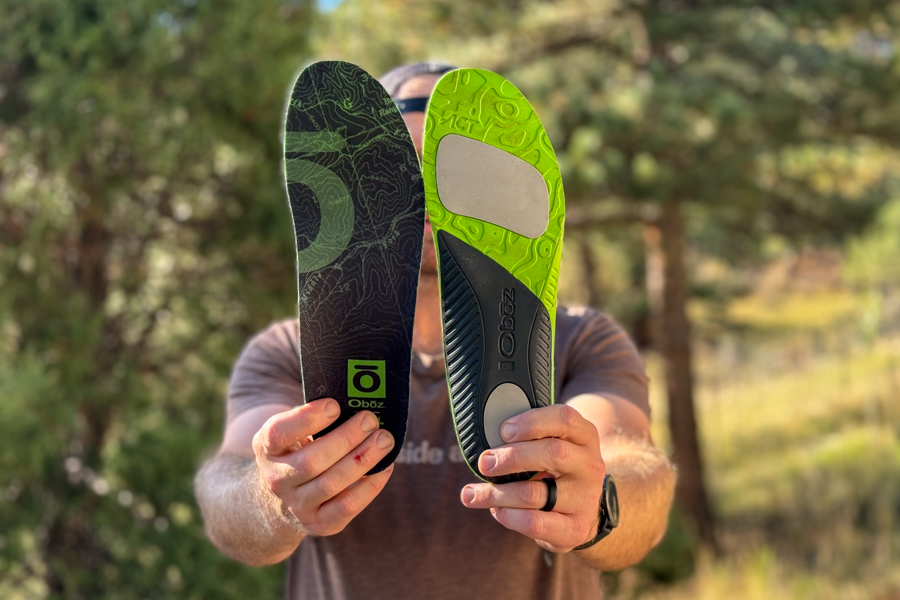
Why Trust CleverHiker?
Ben Dawson, CleverHiker’s lead insole analyst and longtime gear tester, has been logging long miles on trail for more than 30 years – much of it with nagging foot and lower back pain. This uniquely qualified him to evaluate what makes an insole truly effective. As an analyst for CleverHiker’s hiking boot, down jacket, and headlamp guides, he’s spent thousands of hours dialing in the small gear details that can make or break a backcountry trip. This real-world experience, combined with methodical testing over three months and 500+ trail miles, ensures our insole recommendations are both trustworthy and field-proven.
We don’t rely on specs alone. We hike, run, sweat, and repeat until we know what truly works. Every pick in this guide reflects rigorous, hands-on evaluation from a professional who understands how gear performs under pressure and what your feet really need on the trail.
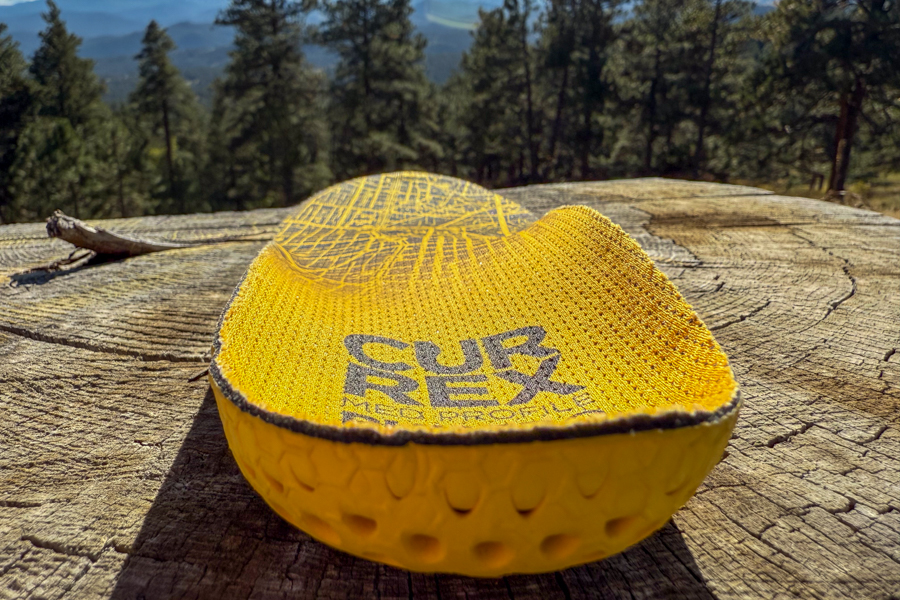
Analysis & Results
VALUE
Insoles vary widely in price, design, and purpose. While premium models often promise better performance and longevity, value isn’t always tied to how much you spend. The real measure of value comes down to how well an insole fits your foot, complements your footwear, and solves actual problems without creating new ones. For hikers, runners, and everyday users alike, the best insole is one that makes your feet feel better for the miles you cover.
After more than 50 trail miles with each model, our top choice for overall value is the Oboz Trail Insole. At just $35, it’s one of the least expensive insoles in our lineup, yet it holds its own against premium options that cost twice as much. It offers a comfortable balance of support, shock absorption, and flexibility while maintaining a low profile that works with most hiking shoes and boots.
Close behind is the Currex HikePro, which comes in at a higher price point but delivers top-tier performance across every metric we evaluated. These were the only insoles we truly forgot we were wearing. The comfort, stability, and quality craftsmanship justify the cost for hikers who want a more refined, performance-oriented option.
At the opposite end, premium options like the Tread Labs Pace and Superfeet All-Purpose Support feel overpriced for what they offer. They’re well-made and supportive. But, when factoring in cost, comfort, and performance, they don’t stretch your dollar as far as our top picks.
FIT & COMFORT
When it comes to insoles, fit and comfort are everything – and often the most subjective part of the experience. Our testing focused on how each model integrated into various types of footwear and whether it enhanced or disrupted the natural feel of the shoe.
The Currex HikePro and Currex RunPro came out on top for overall fit and comfort. These insoles provide subtle support coupled with all-day wearability. We consistently forgot they were even in our shoes, a rare and telling compliment.
Coming in third, the SOLE Active Medium offered a more structured feel but impressed us with its heat-moldable design. They felt stiff out of the box, but once broken in, they provided a supportive and customized feel that blended in nicely with a range of footwear.
At the bottom of our list, the Superfeet All-Purpose Support Medium Arch insoles (often referred to as “Superfeet Blues”) felt a bit too firm and flat for our analysts. While they’re fine as an entry-level upgrade, they offered little in the way of cushion or personalized comfort. Even further down, the Vivobarefoot Thermal Insole is designed for warmth, not comfort. It provides almost no arch support and less cushioning than many stock insoles in most shoes.
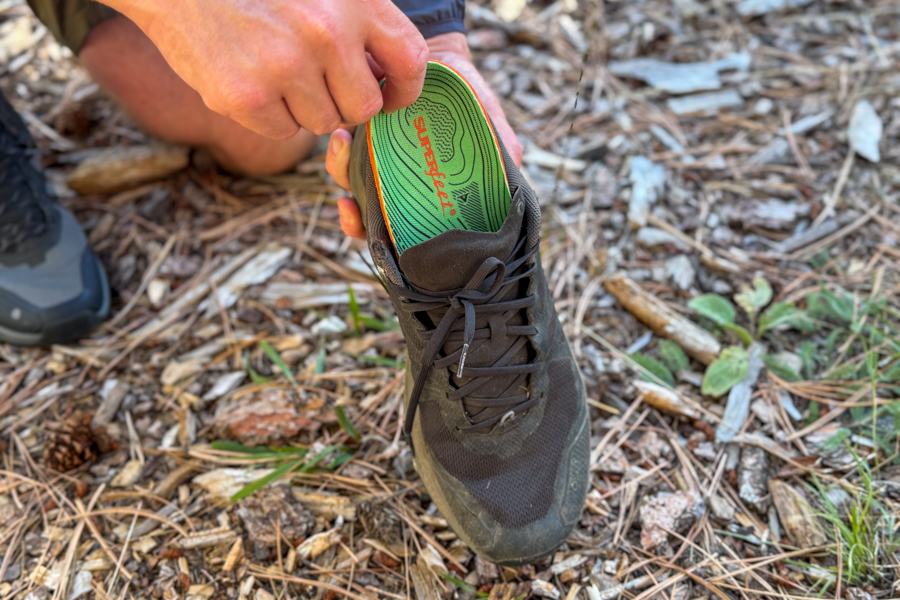
SUPPORT
Support isn’t just a nice to have. It’s the dealbreaker for many insole users. Whether you’re trying to correct alignment issues, alleviate plantar fasciitis, or just stabilize your stride, the right amount and placement of support can make or break your hiking or running experience. In our testing, we focused on arch shape, firmness, heel cup design, and how well each insole cradled and guided the foot through long miles.
The most supportive models in our lineup were the SOLE Active Medium, Tread Labs Pace, and Superfeet Hike Support insoles. The SOLE Active offered a secure and corrective feel that became more comfortable after molding to the shape of our analysts’ feet. Its moderate arch and defined heel cup scored high marks for structure and adaptability.
The Tread Labs Pace stood out for those who want a more aggressive, locked-in feel. Its firm arch and deep heel cup made it an excellent choice for hikers needing consistent support over rougher terrain. It took a few hikes to break in, but once molded, it gave us confidence-inspiring structure without feeling too rigid.
Meanwhile, the Superfeet Hike Support featured one of the most noticeable high-arch designs we tested. The firm heel stabilizer helped guide foot motion and improved comfort for testers who overpronate or carry heavy packs.
At the opposite end, some insoles offered minimal arch contour and felt more like a stiff stock insert than a true upgrade for those needing support. The Vivobarefoot Thermal Insole, designed strictly for minimalist footwear, offers essentially no additional support. They’re nice for barefoot purists but insufficient for most hikers and runners looking for a supportive insole.
DURABILITY
At CleverHiker, we always applaud gear that’s made to last. For many users, especially hikers and trail runners, durability is key to justifying the investment. After all, it’s no good having the perfect fit and support if the insole starts to peel, flatten, or lose integrity after just a few hikes.
Our top performers for durability were the SOLE Active Medium Insoles, Superfeet Hike Support Insoles, and Currex HIKEPRO Medium Insoles. All three held up really well across more than 50 miles of rocky, wet, and dusty trail conditions in Colorado’s high country and foothills. The SOLE Active’s heat-moldable base and dense materials resisted breakdown, while the Superfeet Hike Support impressed us with its firm structure and rugged top layer. The Currex HIKEPRO surprised us most. Despite being low-profile and minimal, it avoided premature delamination and flattening better than many other options.
On the flip side, the Oboz Trail Insoles and Vivobarefoot Thermal Insoles showed the most durability concerns. The Oboz Trail model felt great out of the box but began to compress noticeably by the end of testing, especially under the heel and ball of the foot. The Vivobarefoot Thermal Insoles are designed more for warmth than longevity, and it showed. These insoles are thin and soft, and by the end of testing, we noticed slight fraying around the edges, especially in high-friction areas.
CUSHION
The right level of cushioning can completely change how your feet feel after a long day on the trail. Well-cushioned insoles absorb impact, reduce stress on joints, and help your feet stay comfortable through repeated pounding, especially on descents or hard-packed trails or pavement.
Our top picks for cushioning are the SOLE Active Medium Insoles, Superfeet Run Cushion Medium Arch Insoles, and PowerStep Pinnacle Insoles. The SOLE Active has an EVA base that adapts to your foot over time while still offering noticeable shock absorption straight out of the box. Superfeet’s Run Cushion lives up to its name with energized zones in the heel and forefoot that reduce impact and maintain a responsive ride on pavement and trail alike. The PowerStep Pinnacle is one of the plushest options in our lineup, especially for folks dealing with foot pain. Its dual-layer cushioning and thicker construction may feel bulky in low-profile shoes, but it helps with all-day comfort.
At the bottom of our cushion rankings are the Oboz Trail Insoles and Vivobarefoot Thermal Insole. The Oboz Trail is still comfortable, but it leans heavily on flexibility and rebound, offering less impact protection than others. The Vivobarefoot Thermal is in a different class altogether. It’s designed for insulation, not cushion – and may even feel firmer than your stock insoles.
ODOR MANAGEMENT
More than likely, foot odor isn’t the first thing you think about when choosing insoles. But it becomes very noticeable on multi-day trips or hot, high-mileage days. We paid close attention to how each model managed sweat and humidity across all types of footwear and trail conditions.
The Currex HIKEPRO Medium and RunPro Medium Insoles stood out as top performers for keeping the stink at bay. Both models feature moisture-wicking topsheets with built-in anti-odor treatment, and we found they stayed fresher than most. The SOLE Active Medium also does well with odor management. Thanks to its open-cell foam and antimicrobial layer, it dries quickly and resists odors even after repeated use.
At the other end of the spectrum, the PowerStep Pinnacle insoles have excellent support but tend to run hot and trap moisture. After a few long hikes, they began to retain noticeable odor, especially in less breathable footwear. And the Vivobarefoot Thermal Insole showed poor odor control overall. Its focus on insulation means it traps heat and moisture, leading to faster odor buildup – even with limited use.
If long-term freshness is a priority, stick with moisture-wicking and antimicrobial models like those from Currex and SOLE.
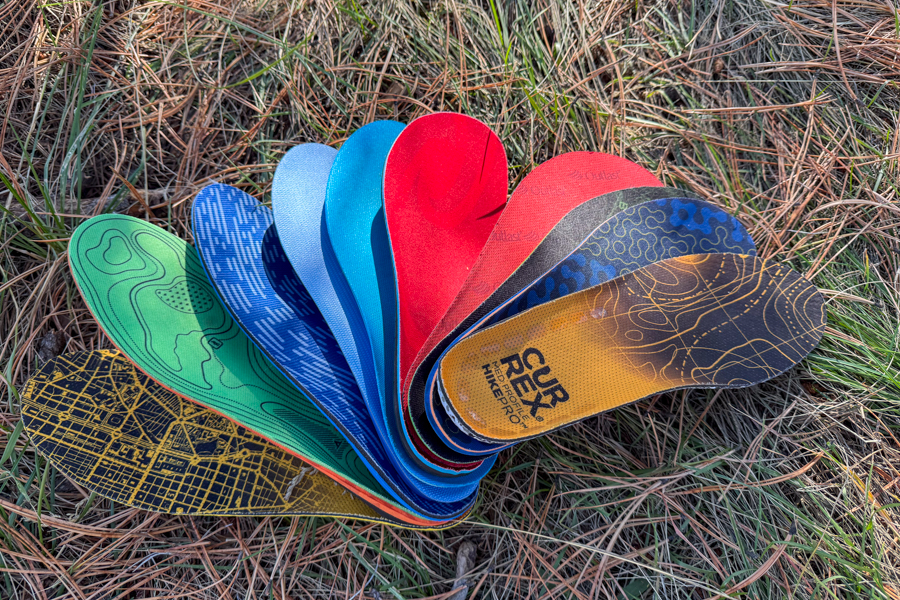
How to Choose aN INSOLE
The right pair of insoles can drastically improve your hiking, running, or everyday experience, but choosing the best one for your needs isn’t always straightforward. From arch support and cushioning to volume and durability, the ideal insole is highly personal. Here’s what you need to consider to make the right call.
ARCH SUPPORT
Arch shape and support are two of the biggest differentiators between insoles. Some models offer minimal structure for natural foot movement. Others are rigid with aggressive arch reinforcement. If you have flat feet or high arches or if you experience discomfort like plantar fasciitis, opt for an insole that matches your arch height and provides enough structure to promote alignment and reduce fatigue. Brands like SOLE and Superfeet offer insoles in multiple arch heights, which can be helpful for finding the right fit.
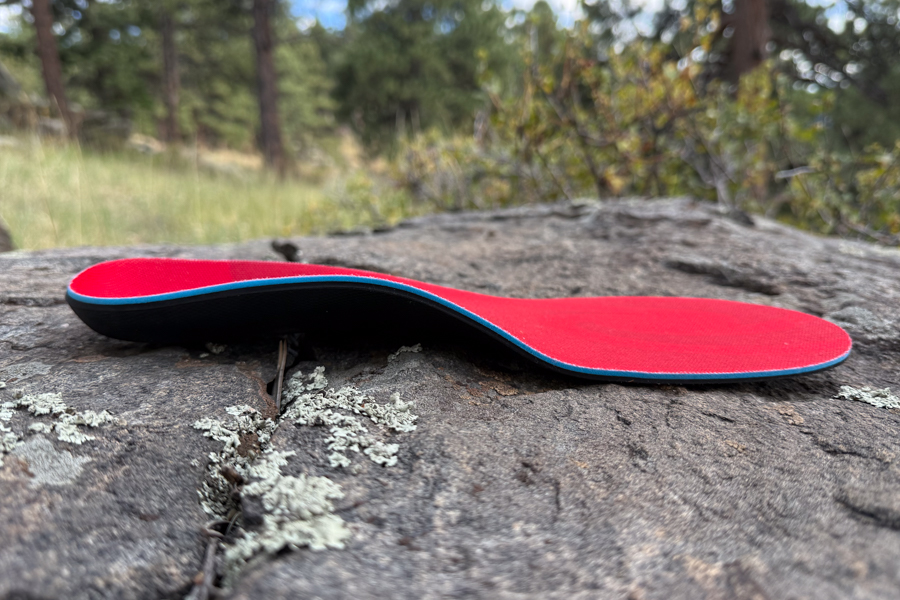
CUSHIONING
Arch shape and support are two of the biggest differentiators between insoles. Some models offer minimal structure for natural foot movement. Others are rigid with aggressive arch reinforcement. If you have flat feet or high arches or if you experience discomfort like plantar fasciitis, opt for an insole that matches your arch height and provides enough structure to promote alignment and reduce fatigue. Brands like SOLE and Superfeet offer insoles in multiple arch heights, which can be helpful for finding the right fit.
VOLUME & FIT
Insole volume affects how much room the insert takes up inside your shoe. High-volume insoles can crowd the toe box or alter the fit in your shoe, especially in low-profile shoes like trail runners. If your footwear already fits snugly, look for low-volume models designed to preserve the shoe’s original feel. In contrast, high-volume insoles can help take up extra space in roomy boots or correct fit issues.
ODOR MANAGEMENT
Insoles live in a tough environment. Moisture, sweat, and heat can lead to funky smells and bacterial buildup. Some models feature anti-microbial treatments or moisture-wicking topsheets that delay odor. Others don’t hold up well in hot or humid conditions. If your feet tend to get sweaty or you’re in your shoes all day, it’s worth going with something that helps keep the funk at bay.
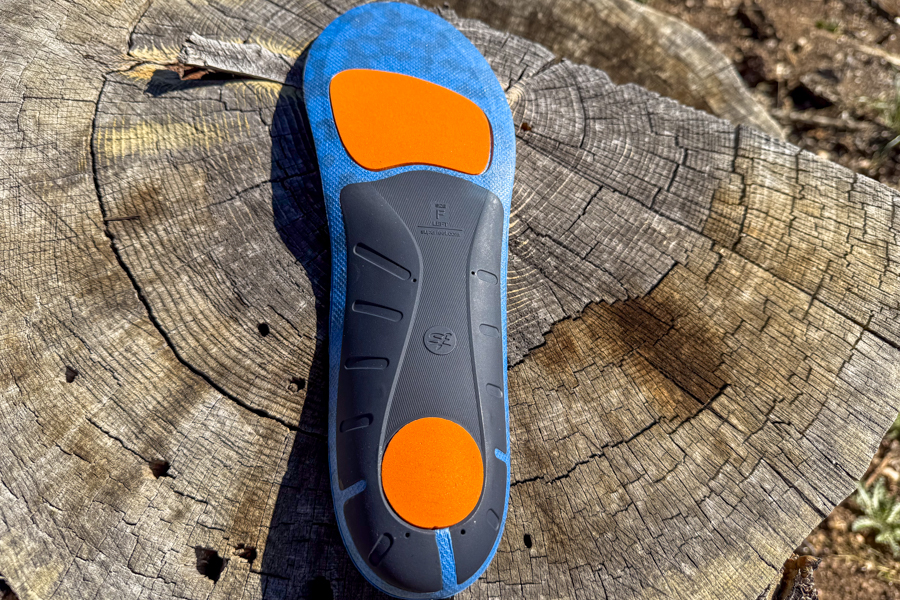
Conclusion
We know insoles might not be the most exciting gear purchase, but they can make a huge difference when it comes to comfort on the trail. That’s why we took the time to really put these to the test, mile after mile, shoe after shoe. Our team has worn all of these insoles on hikes, runs, and everyday adventures, so we can confidently point you toward the ones that actually work. Whether you need more support, better cushion, or just something that helps your feet feel good, we’re here to help you find your perfect fit.
